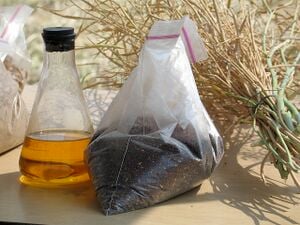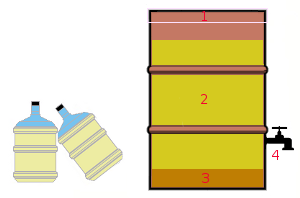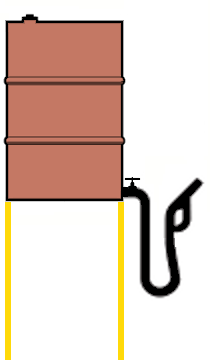
Biodiesel is a biofuel made from pure plant oil which has been treated with chemicals. An alternative approach for making biodiesel that does not involve the use of chemicals for the production also exists. This approach makes use of genetically modified organisms.[1][2] Biodiesel can be used in nearly any diesel engine, with little or no engine modifications. Unlike straight vegetable oilW, it can be used as fuel (new, or waste frying oil) in any engine.
Sources[edit | edit source]


Biodiesel can be made from any[verification needed] fat or oil, such as:
- fish oils (e.g. in Norway[1])
- vegetable oils, which are now often cheaper than regular fuel,[verification needed] if bought in bulk, and we consider that premium cooking oils are not needed.[verification needed]
- used deep frying fat or oil (which would normally be discarded, at economic and environmental cost) - take-away food shops typically have a regular output of this waste.
- Even fat from liposuction operations should be able to be used.[3]
Production from vegetable oil[edit | edit source]
Biodiesel can be produced from straight or cleaned waste vegetable oil. This is not complex and can be done chemically on a small scale. The cleaning of waste vegetable oil is done by straining the liquid trough a muslin, and then separating out the oil by means of a tap or siphon. Additional heating (to 60°C) and agitation (circulation of the oil) is then required to remove any water that may be in the WVO (known as "drying").
The vegetable oil is converted to a useable fuel by combining ethanol or methanol with a catalyst and adding this mixture to the straight or cleaned waste vegetable oil. Small amounts of potassium hydroxide or sodium hydroxide (commonly called lye or caustic soda, which is used in soapmaking) are used as the catalyst material. After this, the SVO/WVO is dried again by heating it to 60°C.
Glycerine then separates out as the reaction takes place and sinks to the bottom of the container. This allready removes the greatest component that gums up the engine. After this an additional step (bubblewashing) is done to remove smaller contaminants. This way, even a modern (direct injection) diesel engine can be run on it. The glycerine can be used as a degreasing soap or refined to make other products.
An alternative approach that does not involve the use of any chemical for the production involves the use of genetically modified organisms.[4][5]
Costs[edit | edit source]
Biodiesel can be made DIY at 18 pence per liter whereas petrodiesel costs 1.32 pounds per liter in Europe.[6]
Advantages and disadvantages[edit | edit source]
An advantage of turning waste vegetable oil into biodiesel is that there is no need to convert the Diesel engine (most current Diesel engines are direct-injection engines which require changes to be done to accept straight vegetable oil; note that older, indirect-injection Diesel engines didn't need this and can accept even straight vegetable oil without doing any changes on it). You can just put it in your tank and drive. Biodiesel is in this regard completely is similar to petrodiesel.
Biodiesel produces less particulates than petrodiesel and is thus much less hazardous to the health of the population, particularly those living in urban areas exposed to significant levels of diesel pollution.[verification needed]
A major disadvantage is the huge amount of work involved. Those that are not afraid of modifying the Diesel engine (to indirect injection) may opt to do this instead. This, in order to get rid of the never-ending work of converting the vegetable oil to biodiesel. Another option (for those that are not yet in the possession of a Diesel engine) is to use an entirely different engine which can run on even the dirtiest fuels. Such engines are Stirling engines, 2-stroke Diesel engines,...
Suggested projects[edit | edit source]
- Search for literature discussing the health impacts of vehicle pollution, and different aspects of the pollution such as particulates vs other pollutants.[expansion needed]
- Design a relatively simple, reliable way of converting vegetable oil (waste and/or new) into biodiesel, to minimize the technical expertise and resources needed, perhaps making it more practical for production in small or medium-sized remote towns.[expansion needed]
- It is claimed by a guest on an episode of the UK TV show Top Gear[2] that adding a solvent makes straight vegetable oil runnier (less viscous) and better for use as fuel. The solvent used in the program is non-kerosene-based white spirit (non-kerosene based for tax purposes) added at 3% by volume to filtered used cooking oil. Does this work? Does it reduce the problems of straight vegetable oil, in terms of the long term effect on the car's engine and cold weather operation?[expansion needed] Can other (more common, ecologic) additives be used, e.g. oxyhydrogenW (using a oxyhydrogen booster), ethanol, methanol,...)
See also[edit | edit source]
- Biodiesel Oven
- Biodiesel Tractor Conversion
- Biodiesel Truck Conversion
- Biodiesel auf Deutsch
- Pongamia pinnata, Karanja
References[edit | edit source]
- ↑ Production of biodiesel without using chemicals
- ↑ Jay Keasling using GM microbes to produced biodiesel
- ↑ Fortune in fat, Aftenposten, 6 Dec 2006. Norwegian businessman Lauri Venoy owns a firm in Miami, Florida, was reported to be making an agreement with US hospital giant Jackson Memorial to supply 11,500 liters of human fat per week from liposuction operations.
- ↑ Production of biodiesel without using chemicals
- ↑ Jay Keasling using GM microbes to produced biodiesel
- ↑ Biodiesel made by James Murphy
- Tickell, J., Teickell, K., From the Fryer to the Fuel Tank: The Complete Guide to Using Vegetable Oil as an Alternative Fuel, Greenteach Publishing, 1999.
External links[edit | edit source]
- Make your own biodiesel from Journey to Forever
- http://www.journeytoforever.org/biodiesel_bubblewash.html
- http://www.journeytoforever.org/biodiesel_svo.html
- http://www.biodieselmake.com/
- http://web.archive.org/web/20141004233808/http://www.backyardbiodiesel.org:80/classes.html
- http://www.journeytoforever.org/biodiesel_mike.html
- directions for making biodiesel
- Site listing biodiesel processors
- biodiesel processor
- Biodiesel conversion kits and processors
- Company producing processors
- biodiesel blog
- Footprint Recycling Providing biodiesel in Humboldt County
- NREL Biodiesel This is an excellent PDF going into some of the technical details of the chemistry and processes behind biodiesel production.
- Guide to Biodiesel
- http://en.wikipedia.org/wiki/Biodiesel
- Collaborative Biodiesel Tutorial
- Some innovative DIY biodiesel equipment